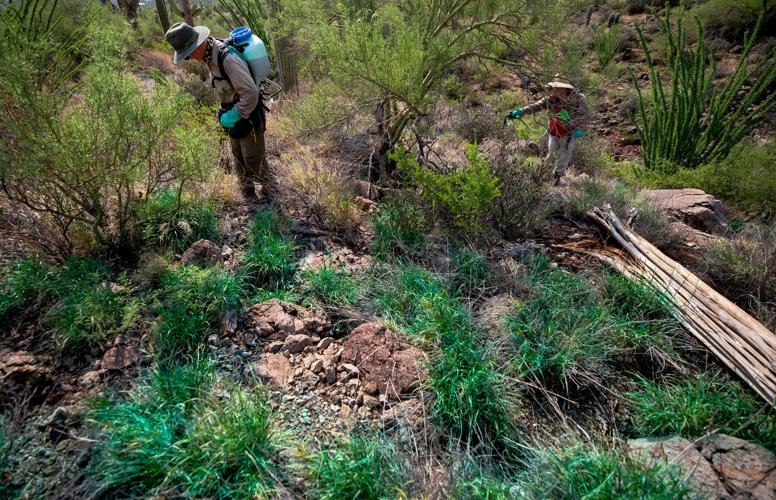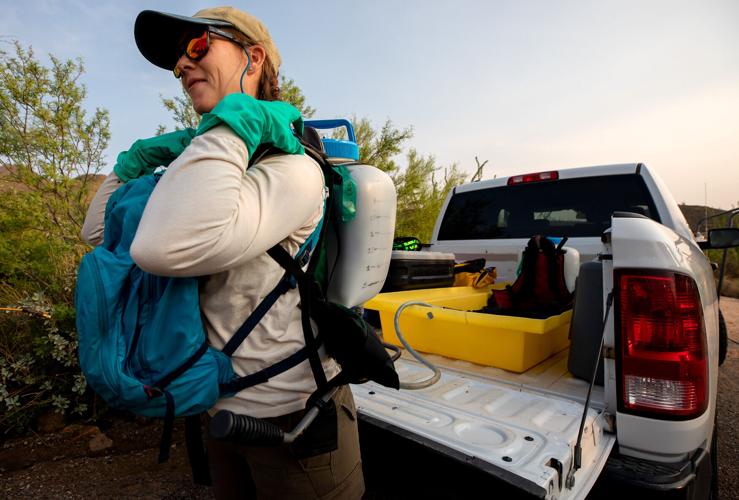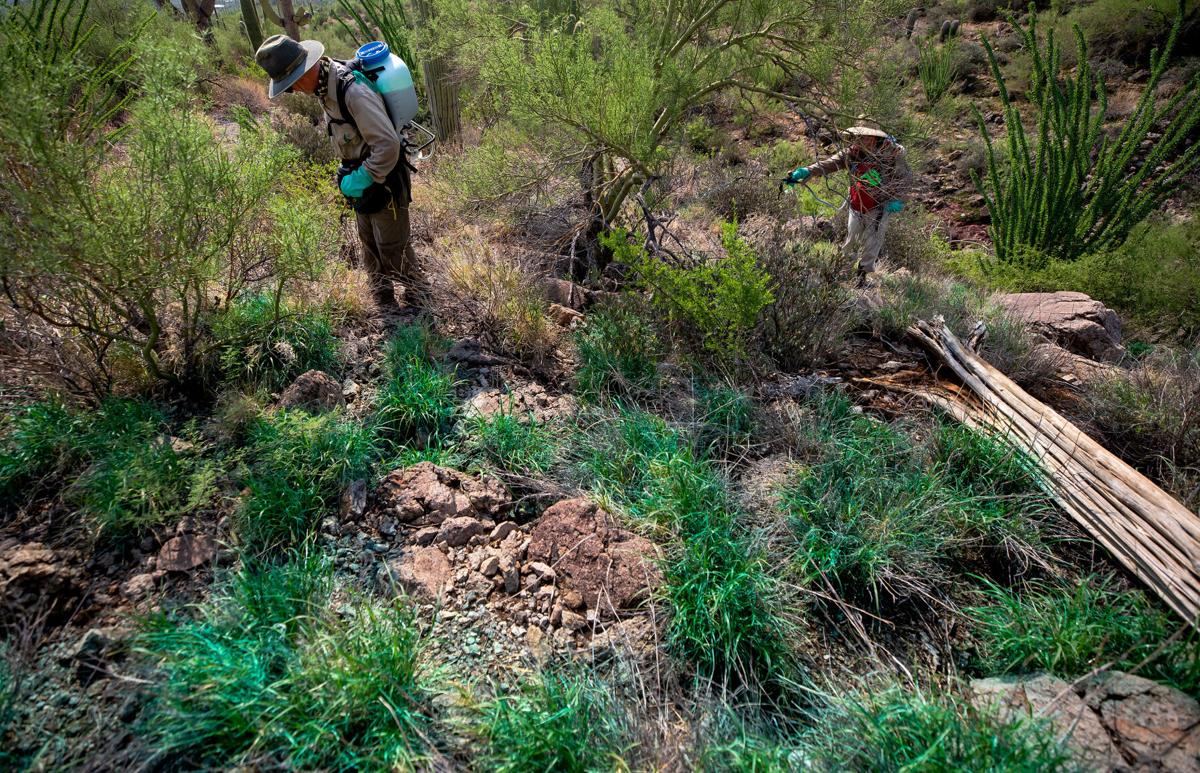Total victory might be out of reach, but Tucson’s war on weeds isn’t a hopeless quagmire.
Experts say buffelgrass and other invasive plants can be brought under control with effort, patience and proper care.
“We do think we can get a handle on it. The goal is to beat it back to a manageable level, where it is an annual maintenance issue,” said Debra Colodner, director of conservation education and science for the Arizona-Sonora Desert Museum.
Buffelgrass isn't the only weed causing trouble in Tucson. Video by Henry Brean/Arizona Daily Star
“We’re not going to get rid of the problem all over all at once,” said John Scheuring, conservation chair of the Arizona Native Plant Society. “It’s an intractable issue, and we have to go after it little by little by little.”
Another couple million dollars wouldn’t hurt, either.
As a start, U.S. Rep. Raúl Grijalva recently announced $50,000 in federal money to treat 158 acres of buffelgrass at three sites in the Tucson Mountains.
In his letter requesting the money, the Democrat from Tucson noted that with $4 million — roughly one-tenth of what the U.S. Forest Service spent to contain last year’s Bighorn Fire in the Catalinas — weed warriors could “restore over 5,000 acres of Sonoran Desert, nearly every acre of buffelgrass in the Tucson Basin.”
A man-made mess
Like so many ecological problems, invasive weeds are a self-inflicted wound.
Hardy, fast-growing grasses from other parts of the world were set free on purpose across the West to control erosion, provide forage for livestock and decorate golf courses and residential yards.
Eventually the weeds spread beyond our control, overwhelming native plants and covering the usually patchy desert floor with an uninterrupted carpet of wildfire fuel.
The most noxious of them all was planted widely in Arizona starting in the 1930s, then exploded about 60 years later, possibly spurred by the record rains and flooding that hit Tucson and Phoenix in 1983.
Buffelgrass is native to Africa and Asia, where it populates grasslands that burn frequently as part of the natural ecological cycle.
Here it spreads even in dry years and readily carries flames through a landscape of saguaros, palo verdes and other native plants not adapted to survive frequent fires.
Experts now consider it an existential threat to the desert ecosystem on par with extended drought and climate change.
“Buffelgrass just replaces everything, even without a fire,” said Perry Grissom, restoration ecologist at Saguaro National Park. “It can convert the Sonoran Desert to those pictures you see of African savanna.”
Flames greatly accelerate the process. Grissom said it burns “hot enough to melt aluminum,” then quickly fills the space cleared by the flames. Left unchecked, he said, it can expand exponentially, its patches doubling in size every seven years or so.

Kara O'Brien, biological science technician for Saguaro National Park, adjusts her herbicide pack before heading out to spray herbicide on buffelgrass in the Tucson Mountains.
“It’s hard to get people excited about a train wreck that hasn’t happened yet,” Grissom said, but without sustained action to curb buffelgrass an ecological train wreck could be headed down the track in just a few decades.
Even the mighty saguaro might not survive. Grissom fears a future where the national park’s namesake plant can only be found in protected gardens at the visitor center or in the yards of homes in Tucson.
“That’s what keeps me up at night,” he said.
Cost and effect
The $50,000 matching grant requested by Grijalva would go to the Arizona-Sonora Desert Museum, which now directs the fight against invasive plants in Pima County through a partnership of 22 different stakeholders working in what is known as the Sonoran Desert Cooperative Weed Management Area.
The group’s diverse membership includes local, state and federal agencies, the Tohono O’odham Nation, the University of Arizona, several conservation groups and the Freeport-McMoRan mining company. The Tucson Audubon Society has formed an Invasive Plant Strike Team to go out after rain events, when conditions are just right for attacking weeds.
The partnership is continuing the work of such entities as the Southern Arizona Buffelgrass Coordination Center and the Buffelgrass Working Group.
The Desert Museum’s Colodner said the federal money will help with an ongoing effort to clear out buffelgrass from Tumamoc Hill and Tucson Mountain Park, restoring them to their natural state over the next 10 years.
“It can’t really be done any faster because it needs to be re-treated every year,” she said.
As for Grijalva’s $4 million projection, Colodner called that a “first-take cost estimate.”
“We’re doing research to nail that number down,” she said.
To do that, researchers are trying to catalog all the buffelgrass in and around Tucson with the help of a few dozen amateur “community scientists,” who spent the first three months of the year mapping the plants wherever they found them.
While it’s possible to “eradicate it locally” in places like Tumamoc Hill, Colodner said there are some spots where containment is the only option.
Pusch Ridge in the Catalinas is one such place. The infestation there is so large and hard to reach that the only option for the moment is to keep it away from nearby homes and clear a series of fire breaks through some of the largest patches to break them up.
Elsewhere, sustained efforts by volunteer groups are making a difference.
The Sonoran Desert Weedwackers have been ripping out buffelgrass in the Tucson Mountains since 2000. Colodner said the progress they have made is as impressive as it is hard won. Much of their work requires “hiking to insane places with a heavy digging bar and a rock hammer,” she said.
Park under siege
Saguaro National Park has been waging war on buffelgrass since 1993.
At first, restoration crews dug the plants out by hand. Then in 2005, they started spraying the weeds with herbicide.
Grissom said one person with a backpack sprayer can easily cover the same area as a crew of 10 with hand tools can pull in the same amount of time.
The park also conducts aerial spraying about once a year, targeting mostly hard-to-reach areas that are at least an acre in size and 50% covered in buffelgrass. The work is done from a helicopter with a sprayer attached to a 40-foot boom or a smaller spot-sprayer lowered on a 100-foot cable.
The most common herbicide used on buffelgrass is glyphosate, known commercially as Roundup. It can also kill native plants such as brittlebush and ocotillo and eventually damage palo verdes and saguaros, so it has to be applied carefully.
“We’re using the least amount of the least harmful herbicide we could find,” Grissom said.
The park spends between $300,000 and $600,000 a year on weed control, including the salaries of Grissom, another full-time staff member and three seasonal employees.
Spending last year was the lowest it has been since 2014, thanks to record dry conditions that made it pointless to conduct aerial spraying, Grissom said. The plants need to be green for the herbicide to work.
Progress is incremental. By Grissom’s calculations, there is buffelgrass in more places in the park than there was in 2012, but the net number of plants has been reduced by about 200 acres as restoration crews thin out dense clumps of the stuff.
One of the park’s worst remaining patches covers about 800 acres in the Rincons near the south slope of Tanque Verde Ridge, a rugged area that hasn’t been treated for buffelgrass at all yet.
Grissom said their work sites are getting more and more remote, which represents both a sign of progress and a challenge. The park service can’t exactly send groups of casual volunteers to pull weeds in places that trained crews struggle to reach.
“If we had more money, we could hire more people and do more stuff,” he said.
Experts needed
A few battles have already been won in the war on weeds.
Over the course of nine years, the Arizona Native Plant Society and the U.S. Bureau of Land Management have removed buffelgrass and restored the native landscape across more than 90 acres of Ironwood Forest National Monument.
Scheuring has also partnered with state and county transportation crews to clear buffelgrass from 145 linear miles of roads in Pima County and with Tucson Clean and Beautiful and the city’s parks department to root out 22 acres of buffelgrass above the loop road on “A” Mountain.

Kara O’Brien, biological science technician for Saguaro National Park, follows the team after spraying a patch of buffelgrass with a greenish/teal herbicide in Saguaro National Park.
Now he’s continuing his work with the U.S. Forest Service and Catalina State Park to clear fountaingrass, Lehmann’s lovegrass and six other unwanted weeds from the riparian canyons along the western slope of the Catalinas.
“We don’t just have a buffelgrass problem. We have a problem with invasive plants,” he said. “We really are in a sea of invasives.”
On a recent Tuesday, Scheuring and regular volunteer Chuck LeFevre hiked into Romero Canyon to check the progress of a spraying campaign that began there in February. LeFevre carried a backpack sprayer filled with about a gallon of herbicide to zap any weeds that may have resprouted after the recent rains.
“You’re going to see a lot of carcasses today,” LeFevre told a reporter who tagged along on the hike. “We think death can be a good thing, as long as it’s the right (plants) dying.”
Scheuring said weed removal has to be done “pretty surgically” to avoid eliminating native grasses and plants. “It’s so important to leave the good guys and let them thrive.”
If done right, less and less herbicide should be needed with each return trip.
That’s one thing Scheuring thinks the overall effort could use more of: “people who know what they’re doing,” namely experts with training and instincts in “weed science.”
They need “the long-term patience and focus to know that it’s not going to be done in a couple of years. It’s going to take six, seven, eight, nine years of sustained spraying,” Scheuring said, followed by years of monitoring and follow-up.
They also need to know how and when to properly apply herbicide to maximize its effectiveness and minimize its collateral damage. Poor timing and a lack of expertise can result in wasted effort and “a lot of misspent money,” Scheuring said.
He thinks Arizona as a whole has some work to do in that regard.
“We no longer have a weed science specialist at the U of A. We no longer have a weed science course (being taught) in the whole state of Arizona,” he said.
Buffel Slayers
Patty Estes used to work as a manager at the molecular and cellular biology laboratory at the University of Arizona. Now she leads the Catalina State Park Buffel Slayers.
In just over six years, the retired researcher and her volunteer army have dramatically reduced the amount of buffelgrass in the park, mostly with their own bare hands.
The nonprofit group Friends of Catalina State Park has chipped in several thousand dollars over the years to sustain the effort — donations that Estes and company have used to buy tools, gloves and thank-you gifts for pull participants.
Overall, though, Estes said the Buffel Slayers have been able to accomplish a lot without spending very much.
“It either takes a lot of money or a lot of people, and some amount of organizing either way,” she said.
As Estes likes to tell kids during outings in the park: “If everybody in Tucson came out one Saturday of their lives and pulled buffelgrass, I think we wouldn’t have a problem anymore.”
The weeds aren’t limited to the open desert.
“There’s buffelgrass growing on corners along Broadway,” Estes said. “It’s all over the roadsides and vacant lots around town, and it’s in every wash.”
In 2012, Pima County won a $2.5 million grant from the Federal Emergency Management Agency to kill the buffelgrass closing in on Tucson International Airport.
Estes first started volunteering with a group of urban buffel busters in Oro Valley. Then she began noticing patches of the plants during her regular walks through Catalina State Park.
She asked park management if she could do something to help, and the Buffel Slayers were born in January 2015. The group has been holding regular outings, usually from November to April, ever since.
Estes still believes buffelgrass can be defeated if enough people do their part.
“It’s going to take volunteer efforts. It’s going to take digging. It’s going to take spraying. It’s going to take chipping away,” she said.
Luckily, motivation is not hard to come by.
“People do get very passionate about losing the Sonoran Desert, about losing the saguaro cactus,” Estes said. “It’s really not a hard sell.”
Arizona's National Parks and Monuments
Saguaro National Monument in Tucson was created in 1933, expanded in 1961, and became Saguaro National Park in 1994. There are two units: East…
Fort Bowie was an Army outpost the served as the staging point for the hunt for Apache Indian leader Geronimo. It had a short and bloody histo…
Established in 1937 by Pres. Franklin Roosevelt, Organ Pipe NM in Southwestern Arizona encompasses more than 330,000 acres, much of it wildern…
Chiricahua National Monument near Willcox, Ariz., established in 1924, is a wonderland of standing-up rocks: pinnacles, spires, sheer stone co…
The site protects one of the largest prehistoric structures ever built in North America.
The Franciscans began work on the mission at Tumacacori in 1800, but the bell tower was never finished. President Theodore Roosevelt proclaime…
Under-the-radar and usually not crowded: The three national monuments easily accessible from Flagstaff – Wupatki, Sunset Crater and Walnut Can…
The Grand Canyon in Northern Arizona was designated a national park in 1919. Along with Yellowstone and Yosemite, it is one of the crown jewel…
WATCH: Mule train supplies remote outpost in Saguaro NP
UpdatedWatch Now: The Douglas Spring Trail east of Tucson
UpdatedThe Douglas Spring Trail is a 16.6-mile out and back hike into Saguaro National Park East and the Rincon Mountains. The trailhead is at the eastern end of Speedway and open to access 24 hours a day. Elevation gain is about 3,700 feet. Difficulty varies, but is generally moderate. Video by Kelly Presnell / Arizona Daily Star 2020















